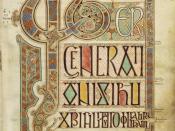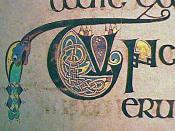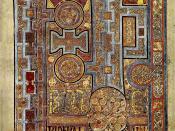From the Museuma. The Crucifixionb. Nivardus of Milanc. C. 1000 - 1025d. Ottonian, Fleury, Francee. Tempera colors, gold and silver on parchmentf. 9 1/8 x 7 1/16 in.
g. picture attached: crucifixion_sarahhess.jpgFrom the Texta. Tunc Crucifixerant XPI, from the Book of Kells, fol. 124rb. Artist unknownc. C. late 8th to early 9th centuryd. Hiberno-Saxon, Irelande. Illuminated manuscript on vellumf. 9 1/2 x 13 in.
g. page 335, figure 9.24Personal ExperienceI walked into the Getty Museum of Los Angeles and the first thing I saw was the French Manuscript Illumination of the Middle Ages Exhibit in the North Pavilion. I went to the Getty with this exhibit solely in mind. I developed an interest in the illuminated manuscripts from our textbook, specifically of insular art and upon learning of the exhibit through the Getty Center Website, chose to attend. I chose 'The Crucifixion' because of the gold border interlace and the use of Christ on the cross as the letter 'T'.
I had seen something similar yet different through our text's section on 'Tunc Crucifixerant XPI, from the Book of Kells, which I chose for comparison.
Analysis of the Museum Piece'The Crucifixion' by Nivardus of Milan is thought to have been created 1000-25 AD. It is comprised of tempera paint on parchment. The folio is a page from a sacramentary and contains the first words of the prayers recited during the preparation of the bread and wine for the Eucharist. The Latin words Te igitur (you, therefore) begin the prayer for the sacrament. The T is represented by Jesus in the classic crucifixion pose on a wooden cross, dressed in only a red garment slung about his waist. His head is encased in a golden mandorla. JesusÃÂ body is not portrayed as slight, but instead as muscular with...


